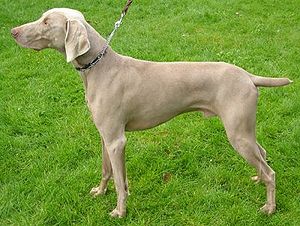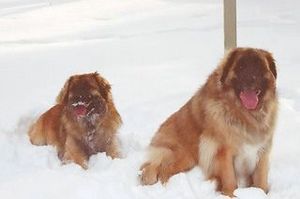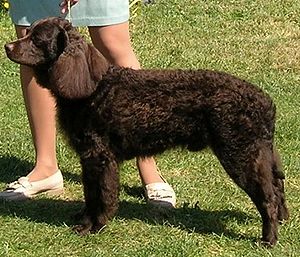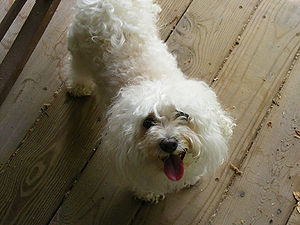 |
| Vital Statistics: |
| Place of Origin: Germany |
| Group: Sporting, Gun dog |
| Height: males 24-27 in., females 22-25 in. |
| Weight: males 55-70 lbs., females 50-65 lbs |
| Life span: 10-12 yrs. |
| Trainability: moderate |
| Good with children: yes if socialized early |
| Good with other pets: usually, may chase small animals |
Known as the “Gray Ghost of Germany” the Weimaraner was bred for hunting. It appears in an early 1600 painting by Van Dyck. In the 19th century the noblemen of Weimar, Germany bred the dog to their speicfication. It was not allowed to be bred outside of Germany until 1929. An American successfully brought the dog to the U.S. where it became popular as a sporting dog. While its origins are unsure, the Weimaraner is a beautifully formed dog.
What does the Weimaraner look like?
The Weimaraner’s head is long with powerful jaws. Height ranges between 22-27 inches tall and weight about 50-70 lbs. depending on gender. The nose is a dark flesh color. Eyes are amber or blue grey and medium sized. Ears are set high and are long with rounded points. Tail is docked where this practice continues. The feet are webbed for swimming. The coat is short and fine. While silver grey is preferred, all shades of grey are acceptable.
What is the Weimaraner’s temperament?
The Weimaraner is an intelligent and wilfull dog and must be trained early and thoroughly with a firm but gentle hand. The Weimaraner must know you are the leader of the pack as this will check any aggressive tendencies. It is very important to get a Weimaraner from a reputable breeder. People with young children or other pets should research this breed thoroughly before making a decision to get one. While it can be stubborn, the Weimaraner is also lively and affectionate and loving.
What are the Weimaraner’s uses?
The Weimeraner is very hardy and with its excellent sense of smell, is a great all-around hunting dog. It is also used by the police, as a watchdog and in search and rescue. The Weimaraner can be a good companion dog for the right person.
Possible Health Issues
Hypertrophic osteodystrophy (affects bones), hip dysplasia, hypothyroidism, tricuspid dysplasia (congenital heart disease), corneal dysplasia, entropion
- American Cocker Spaniel
- Boykin Spaniel
- Bracco Italiano
- Brittany Spaniel
- Chesapeake Bay Retriever
- Clumber Spaniel
- Curly-coated Retriever
- Dalmatian
- English Setter
- English Springer Spaniel
- German Shorthaired Pointer
- Gordon Setter
- Irish Red & White Setter
- Japanese Akita Inu
- Kai Ken Dog
- Karelian Bear Dog
- Labrador Retriever
- Lagotto Romagnolo
- Llewellyn Setter
- Mountain Cur
- Nova Scotia Duck Tolling Retriever
- Picardy Spaniel
- Pudelpointer
- Russian Spaniel
- Spinone Italiano
- Vizsla
- Welsh Springer Spaniel
- Welsh Terrier
- Wetterhoun
- Wirehaired Pointing Griffon
- Wirehaired Vizsla
- American Cocker Spaniel
- Barbet
- Boulet Griffon
- Boykin Spaniel
- Bull Terrier
- Clumber Spaniel
- Curly-coated Retriever
- Dalmatian
- English Cocker Spaniel
- English Setter
- English Springer Spaniel
- Flat-coated Retriever
- German Shorthaired Pointer
- Golden Retriever
- Gordon Setter
- Harrier
- Irish Setter
- Irish Water Spaniel
- Kishu Inu
- Kooiker Hound (Kooikerhondje)
- Labrador Retriever
- Lagotto Romagnolo
- Landseer
- Mountain Cur
- Nova Scotia Duck Tolling Retriever
- Otterhound
- Picardy Spaniel
- Poodle
- Pudelpointer
- Redbone Coonhound
- Redtick Coonhound
- Rhodesian Ridgeback
- Spinone Italiano
- Stabyhoun
- Sussex Spaniel
- Telomian
- Treeing Tennessee Brindle
- Vizsla
- Welsh Springer Spaniel
- Wirehaired Pointing Griffon
- Wirehaired Styrian Mountain Hound
- Wirehaired Vizsla
- Affenpinscher
- Boxer
- Dachshund
- Deutscher (German) Pinscher
- Doberman Pinscher
- Eurasier
- German Shepherd
- German Shorthaired Pointer
- German Spitz (Giant, Standard, Toy)
- Giant Schnauzer
- Great Dane
- Hovawart
- Leonberger
- Miniature Pinscher
- Miniature Schnauzer
- Pomeranian
- Poodle
- Pudelpointer
- Rottweiler
- Standard Schnauzer



